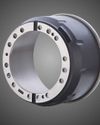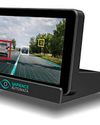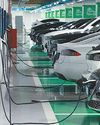RVCR mechanism, the next progressive mutation in machine mechanism, leads to a new generation of multi-fuel engines.

The automotive sector today is focused on electric drive and has caught the attention of the public. But there is a catch 22 type dilemma here. If the oil consumption is reduced by electric engines and oil production continues, oil will become cheaper owing to less demand and excess supply. The battery technology will have to compete with cheaper fossil fuel making it economically unviable. The electric alternative to the existing powertrain systems is limited to automotive which is only a fraction of the powertrain applications and is not applicable to the entire bulk of industrial and commercial applications where the fuel driven prime mover (engine) is used, (as in heavy commercial vehicles; material handling, mining, earth moving equipments, defence applications like tanks, armoured vehicles, aviation (UAV’s to helicopters), marine propulsion (boats, ferries, ships), large power generation units etc. The significance of engines to industry remains. Unhooking of fossil fuel dependency is not as simple as switching to electric cars, rather it is a transition to technological solutions for greener alternatives. It is this challenge that a new revolutionary ‘RVCR technology’, based on an invention in engine kinematics by an Indian engineer and inventor Das Ajee Kamath.
Conventional engine vs RVCR Technology: RVCR is a seed-machine kinematics that has various downstream applications in engines, renewable energy power generators and utility machines. RVCR enables a feature called ‘VCR’ (Variable Compression Ratio) which specially revolutionises engines. RVCR is a leap in technology compared to conventional engines and differs in the very makeup of the way engines work.
This story is from the November 2017 edition of Auto Components India.
Start your 7-day Magzter GOLD free trial to access thousands of curated premium stories, and 9,000+ magazines and newspapers.
Already a subscriber ? Sign In
This story is from the November 2017 edition of Auto Components India.
Start your 7-day Magzter GOLD free trial to access thousands of curated premium stories, and 9,000+ magazines and newspapers.
Already a subscriber? Sign In

U.S. COMMERCE DEPARTMENT ISSUES PRELIMINARY DECISION ON TURKISH BRAKE DRUM SUBSIDIES
On December 06, 2024, the U.S. Department of Commerce announced a preliminary affirmative determination in the Countervailing Duty (CVD) investigation concerning certain brake drums imported from the Republic of Türkiye as per The Brake Report.

BHARAT MOBILITY GLOBAL EXPO 2025 THE COMPONENTS SHOW PREVIEW
The Bharat Mobility Global Expo 2025, slated for January 17-22, is ready to dazzle the world with its expansive and innovative display of automotive and mobility solutions, writes Ashish Bhatia.

INTELLIGENT TRAILERS
Today's trailer customers enjoy access to a complete range of integrated solutions, writes Ashish Bhatia.

UNLOCKING THE POTENTIAL OF USED EVS IN INDIA'S GROWING EV MARKET
India's EV market, valued at USD 2 billion, is on the fast track to becoming the third largest globally by 2025. However, maintaining this momentum will depend heavily on developing a robust second-hand EV market

SAPIENCE HARNESSES AI FOR ROAD SAFETY
Sapience Automata is banking on Al-driven ADAS innovations to curb accidents, and improve fleet efficiency, writes Upendra Kasbekar.

TRAFFIC SURVEILLANCE SOLUTIONS
CP Plus is offering innovative traffic surveillance solutions to enhance on-road safety. writes Richa Tyagi.

LEGACY BRAND RENEWED PURPOSE
As Godrej Enterprises Group celebrates its 127th anniversary, the company unveiled a bold vision to chart a sustainable and innovative path forward, writes Ashish Bhatia.

GLOBAL AUTOMOTIVE SOLUTIONS
Raghavan Sampath, Director of Business Development, India Business Development Division at MediaTek, shared the company's strategic approach of offering global automotive solutions, with Richa Tyagi.

SOUTH KOREAN BATTERY MAKERS' DECLINING SHARE
Three South Korean electric vehicle battery makers saw their combined global market share fall from a year earlier in the first 10 months of 2024 amid robust growth of Chinese rivals, industry data showed on Monday.

UNO MINDA GPT-ENABLED MUSIC SYSTEM
Uno Minda Ltd. has introduced India’s first GPT-enabled Android music system, the WTUNES-464DN-GPT, revolutionizing the in-car experience.